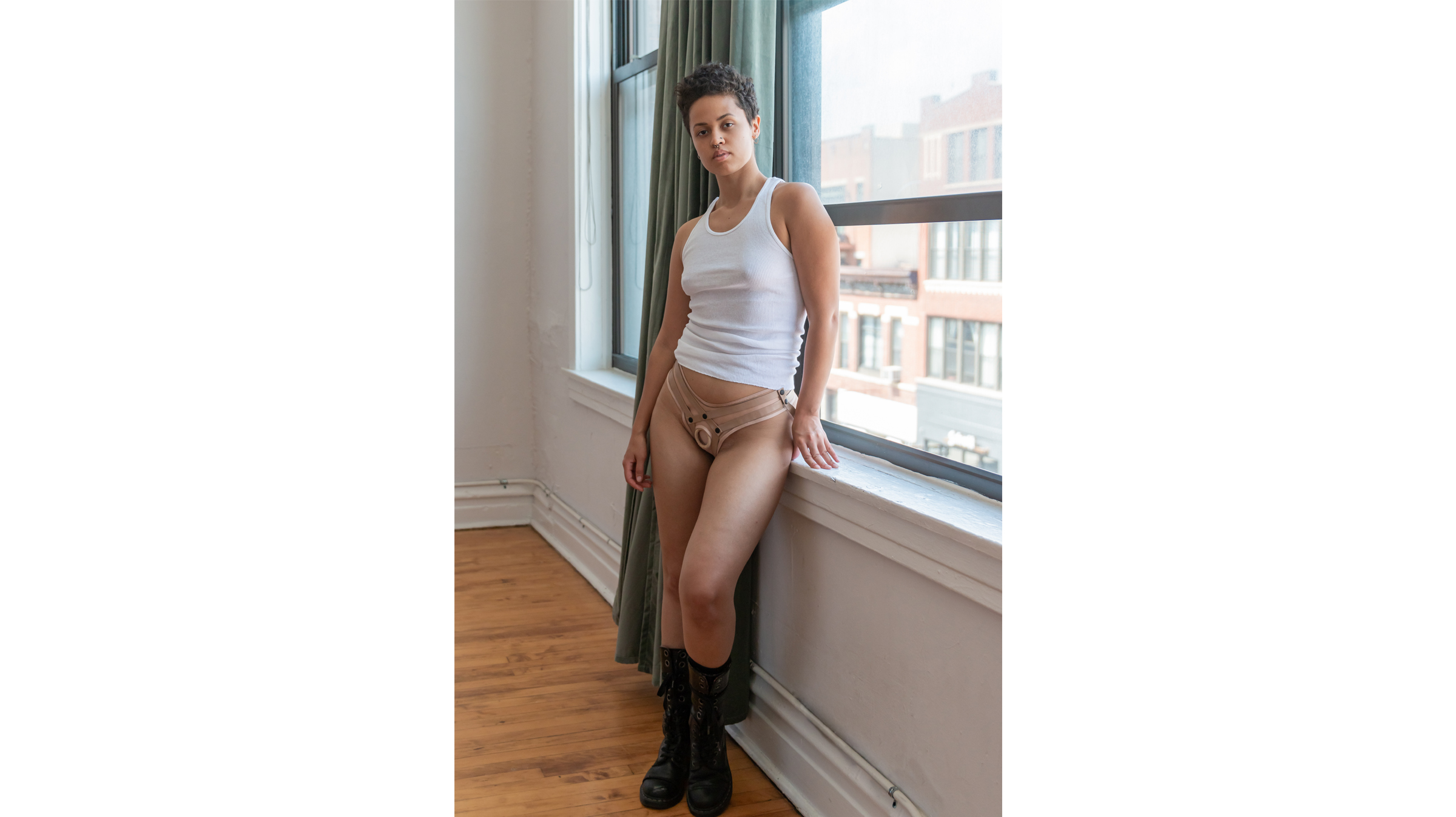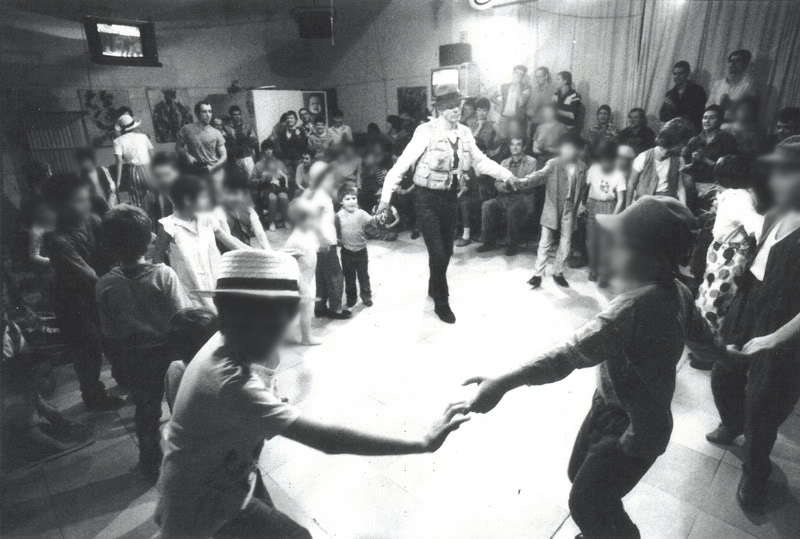When Shawné Michaelain Holloway isn’t making new media art or teaching in the New Arts Journalism department at the School of the Art Institute of Chicago, she is working the counter at one of Chicago’s premier sex stores, Early to Bed. The Chicago native has been retailing at sex shops since she was 18 years old. She likes the opportunity to facilitate sex lives—helping people find the right products: dildos, vibrators, butt plugs, handcuffs.
Over the years—during which she’s also taught weekly kink and sex-ed classes—Holloway has gotten to know the social dynamics of the sex shop ecosystem. She’s noticed, for instance, that one section of the store always seems to elicit particular uneasiness: The corner where the strap-ons hang.
Videos by VICE
“I just continuously saw a lot of shame in that corner,” Holloway tells Broadly, “whether that’s because heterosexual couples were fearing that they were doing something gay, or masculine women feeling shameful about the fact that they have to put on a thing at all, or people of color who came in and didn’t see themselves reflected in the things we have.”
In her years of sex toy retail experience, Holloway also noticed something else: Even as the sex toy industry consistently grew and designers became increasingly inventive, the design for the strap-on harness has barely changed at all. So, in August of 2017, when she was given the opportunity to join a business accelerator program for artists, she decided to rethink the strap-on with millennials in mind.
Holloway came up with STRAPP, a sleek harness whose design is inspired by extensive conversation with a range of strap-on users about how they’d like to see the strap-on harnesses be more functional and affirming. After initially debuting the design as part of the exhibition, I Was Raised on the Internet at the Museum of Contemporary Art Chicago in the fall of 2018, Holloway is now looking to bring the product out of the gallery and into mainstream sex stores.

As an undergraduate in college, Holloway was studying to become a lawyer. At the same time, she was doing sex work and avidly practicing BDSM. “I didn’t have time to be my kinky self, do sex work, and go to school,” she recalls. “So I thought, How do I make all this work?”
The answer she landed on was becoming a professional artist. Today, she’s acclaimed for her new media and performance art that—among other things—interrogates the power relations inherent in digital interfaces, often through a sexual lens. “A lot of times, I use my own kink practice as a way to discuss larger power dynamics and really take it one-for-one: What is the dominant? What is the submissive? I find this sexual involvement really, really useful for talking about other things, even as mundane as data processing,” she says. “So I get to talk about sex all the time—it’s really just a scheme that I’ve cooked up.”
Although informed by her fine art background to a certain extent—sex toys are a kind of interface—STRAPP is a sincere business venture, rather than simply a conceptual art piece.
The project started when Holloway enrolled in artist Jeremy Bailey’s Chicago-based seed business accelerator program Lean Artist, grounded by the prompt: “Can a business be a readymade?” Her next step was market research, then hold a focus group of a dozen diverse strap-on users (including trans-masculine individuals, heterosexual individuals, lesbians, and people with a range of body types), and casual conversations with about 50 others to identify what was lacking in the strap-on market.

There were a few things Holloway heard over and over again: Most strap-ons are too difficult to put on, making the wearer feel clumsy and unsexy. Once on, they are often uncomfortable, with too many straps. (One person told her they hated the strappy design so much, they wouldn’t wear a strap-on without wearing underwear over it.) And for people with larger bodies, if they could find one that fit, it often wouldn’t function the way it was supposed to—with the dildo flopping downward.
With this feedback in mind, Holloway set off on a design process involving many hand-sewn prototypes and a collaboration with a design consultant. One way her approach may have differed from others: She says she think of the product as a kind of sportswear, letting go of the idea that it should be sexy, and focusing on functionality with the intention of normalizing harnesses. “I want them to be in Target,” she says. “I want them to be in Walgreens.”
What sets STRAPP’s design apart is its high-V waistline, which Holloway says she chose to be in line with current high-waisted fashion trends while also being shape affirming and creating a secure fit on a range of body sizes. Additionally, all the straps have self-containing mechanisms, so that there’s nothing hanging off and flapping around or chaffing the skin because it’s tucked in. Meanwhile, strategic buckles and snaps aim to make putting it on easy, while modular design means its mesh and fabric lining can be put in the washing machine.

After an unsuccessful Kickstarter campaign in November, Holloway is now building partnerships and seeking further investors in order to start manufacturing the first STRAPP products—which she aims to make in sizes ranging from XXS to XXXL. Right now, the projected retail price is $270. But Holloway’s eventual goal is to begin selling a $60 version of the design, made with less expensive materials and fewer sewing details—the price of which will be offset by the cost of the high-end version.
For More Stories Like This, Sign Up for Our Newsletter
“It’s kind of shockingly similar to being an artist,” Holloway says of her experience of writing applications for funding and incubator programs for entrepreneurs. “Artistic work and imposter syndrome are very closely related sometimes, and it’s taking that away for me.”
“I come from a long line of people who have started their own businesses…and it’s the first time I’ve ever been able to participate in these conversations, so it feels really good. And as a woman of color who is lesbian identified, I’m happy to be able to give back to the community who helped me—ever since I was 18—reach my own realizations about myself. Hopefully that can just recycle.”
More
From VICE
-

Collage by VICE -

Allmodern -

Collage by Vice -

Children at the Friedrichshof Commune dance with renowned artist Joseph Beuys. Inka, aged four, holds his right hand.
